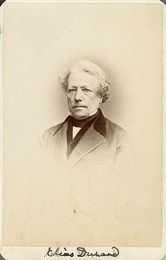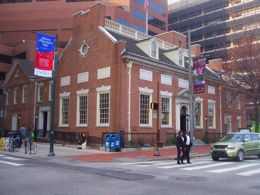Related Topics
Science
Science
French Philadelphia
French Philadelphia
Natural Science
foo
Pictures in the Library
On the walls of the Reading Room of the Academy of Natural Sciences in Philadelphia are 38 portraits of the most famous scientists of 19th Century America. Here are three of them.
Elias Durand

|
| Elias Durand |
Philadelphia has a long and bumpy history with the French, more or less paralleling the British wars with them. But when the guillotine threatened aristocratic necks, Philadelphia offered a sanctuary of new world enthusiasm and sophistication. A few years after the terror, during the reign of Napoleon Bonaparte, Americans scorned his monomaniacal approach to government, returning to the British disdainful view of Frenchmen. In another era, Philadelphia would change its view, displaying a prominent collection of sculptures by the famous French artist, Rodin. And in today's political climate, of course, the French and their socialist leanings are akin to the devil incarnate. It can not be denied, however, the French had a major influence on Philadelphia society and culture. Elias Durand, a former member of the Academy of Natural Sciences whose portrait hangs in the Library Reading room, was a French refugee whose love of Botany greatly expanded American understanding and knowledge of plant life in North America. Somehow, that seems appropriate for an educated Frenchman. But his achievements in commerce were at least as important to his adopted city as his intellectual ones.
The youngest of fourteen children, Durand was born in Mayenne, France in 1794. A passionate chemistry student, he studied pharmaceuticals in school where he was also introduced to the subjects of natural history, mineralogy, geology, and entomology. His rich education in both Mayenne and Paris expanded his interest in chemistry to include the interplay between the hard sciences and the natural world. In 1812, after studying in Paris, Durand joined Napoleon's army, where he served as a medic and "Pharmacien," overseeing the opening of hospitals and the care of wounded soldiers. Even while serving in one of France's most historic wars, Durand remained passionate about the world of plants, by some accounts even collecting plants during the notoriously bloody Battle of Leipzig.
When Napoleon's luck turned bad, Durand focused his attention back to chemistry. In 1814 he left the army and moved to Nantes, where he worked briefly as an apothecary, as well as a lecturer on Medicinal plants in the regional Academy. Durand would remain a teacher throughout his life, instilling those around him with a fascination and passion for the Natural Sciences.
Always a patriotic Frenchman, however, Durand rejoined Napoleon's forces during the general's final hurrah, the "100 days." After Napoleon sustained his ultimate defeat at the battle of Waterloo, Durand retired from military duties and focused once again on the study of pharmaceuticals. His earlier connections to Napoleon, however, led to some uncomfortable clampdowns on the young man's freedom; Durand left the country in disgust in 1816 at being forced to report himself to the police every morning. He sailed to New York in pursuit of a life free from politics and dedicated to his passions of botany and chemistry.
Durand was quickly welcomed into the homes of other French ex-patriots living in Boston and soon met ambitious and science-oriented men who encouraged the young chemist to stay in the country. Hearing there might be work with Dr. Gerard Troost, the first president of the Academy of Natural Sciences, Durand traveled by foot to the mid-Atlantic region. This adventure brought him into contact with local Native Americans, whom he found friendly, as well as local native colonists, whom he found less so.
After a long and arduous journey down the East Coast, Durand finally arrived in Baltimore, only to learn that Troost was not in need of an employee. He was, however, desperate for a companion, and after spending several weeks in Troost's company, Durand left to find work in Baltimore with increased enthusiasm for Botany and in particular native species of North America.
In Baltimore, Durand found work with Mr. Ducatel as a pharmacist and apothecary. He quickly settled into the business, gaining experience in the field and eventually marrying Mr. Ducatel's daughter. But after five years in Baltimore, with both his wife and his father-in-law had passed away, Durand left Baltimore to search for new opportunities.

|
| Former Pharmacy at 6th and Chestnut |
He found them in Philadelphia. Perhaps because of the city's burgeoning field of Natural History or its emerging reputation as a medical town, Durand became committed to forging a career in Philadelphia. With the hope of opening a pharmacy in the finely decorated "European Style," Durand returned to France in 1825 to collect materials for this undertaking. Upon his arrival back to town, he set up a shop at 6th and Chestnut streets. His store quickly became world renown for its unique and finely produced medicinal pharmaceuticals, unique in its access to both old world and new world innovations.
Philadelphia proved to be a good move for the young Frenchman; in the next few years he married Marie Antoinette Berauld, a refugee from the St. Domingo Insurrection, and achieved election to the Philadelphia College of Pharmacy.
After his wife died in 1851, Durand gave up business to pursue the study of Botany. He was elected to the Academy of Natural Sciences in 1852, and during his membership published numerous articles and books on the botanical findings of expeditions to the American West and the Arctic. Durand also contributed to the study of Botany through the publication of several biographies about the lives of botanists Thomas Nuttall and Andre Michaux, the famous arborist. Durand's deep and lifelong appreciation for the study of Botany helped bolster the Academy's resources during his membership.
As Durand grew older, his French roots called him back to the homeland; in 1860 he returned to France, and finding the collection of North American specimens lacking in the Jardin des Plantes de Paris, determined to expand the collection himself. He returned to Philadelphia and spent the remainder of his life developing his collection of North American specimens with the help of his son. Eight years later, in 1968, Durand shipped his collection of 10, 000 specie herbarium to Paris where it was arranged in a special gallery named after him, the Herbia Durand. Much of Durand's remaining collection, however, was left to the Academy after his death.
After this long, varied and successful career in the world of Natural Science, Elias Durand died in his home on 9th and Broad Streets (sic) in 1873 at the age of 80. He had contributed greatly to the fields of Botany and helped to establish Philadelphia's respected reputation in the world of medicine. Although a Frenchman at heart, Durand remains a feather in Philadelphia's cap and an important face at the Academy of Natural Sciences.
Originally published: Wednesday, November 24, 2010; most-recently modified: Monday, May 20, 2019